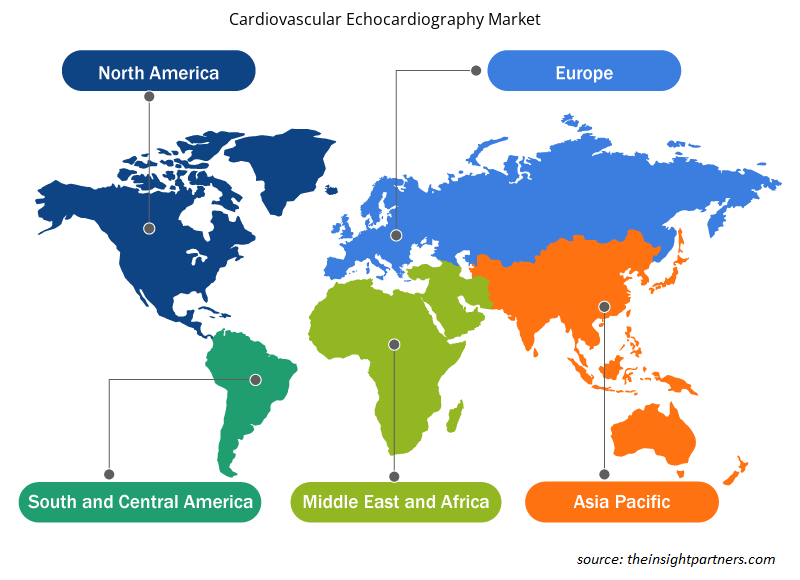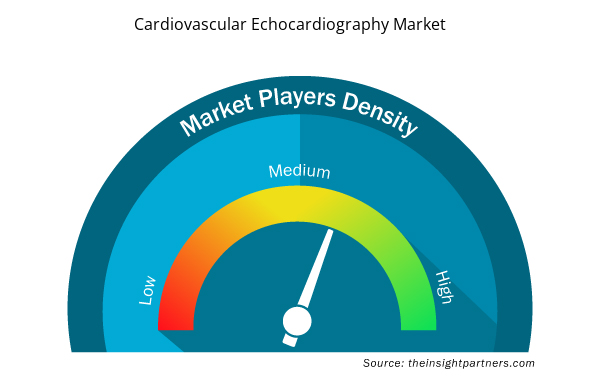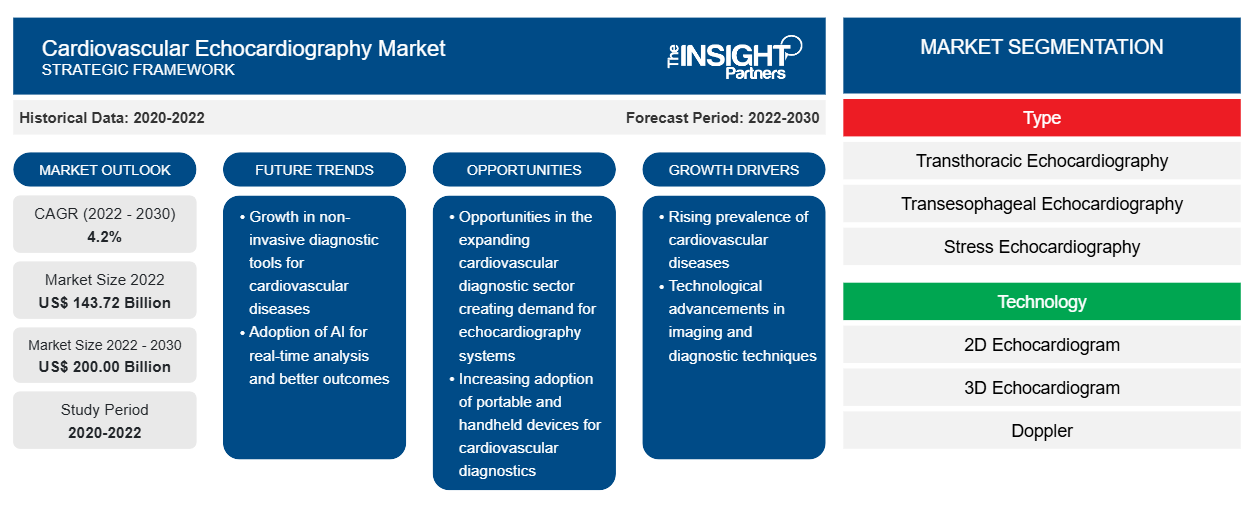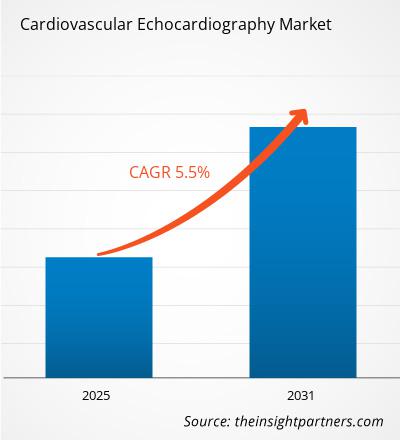[Rapporto di ricerca] Si prevede che il mercato dell'ecocardiografia cardiovascolare raggiungerà i 200,00 miliardi di dollari entro il 2030, rispetto ai 143,72 miliardi di dollari del 2022; si stima che il mercato registrerà un CAGR del 4,2% nel periodo 2022-2030.
Approfondimenti di mercato e opinioni degli analisti:
L'ecocardiografia cardiovascolare è un tipo di imaging medico per esaminare il cuore. Utilizza onde sonore per creare immagini visive del cuore. Questa procedura di test viene solitamente eseguita su pazienti con malattie cardiache sospette o note. Oltre a rivelare le dimensioni e la forma delle camere e delle valvole, il test stima anche il funzionamento del cuore calcolando la gittata cardiaca, la frazione di eiezione e la funzione diastolica. L'ecocardiografia cardiovascolare può anche rilevare cardiomiopatie. Le lesioni del precedente infarto possono essere chiaramente visualizzate utilizzando ecocardiografi. L'ecografia cardiaca transtoracica, transesofagea e da sforzo sono tra i vari test di ecografia cardiaca eseguiti a fini diagnostici. Si prevede che il crescente carico di malattie cardiovascolari e la crescente popolazione geriatrica creeranno ampie opportunità per la crescita del mercato dell'ecocardiografia cardiovascolare .
Fattori di crescita:
Durante l'esame e la valutazione di infarto, dolore al petto, malattia coronarica, coaguli di sangue e altri disturbi cardiaci, i medici raccomandano trattamenti invasivi che comportano esami del sangue e cateterizzazione cardiaca. La cateterizzazione cardiaca richiede una degenza ospedaliera prolungata e causa alcuni effetti collaterali come sanguinamento, coaguli di sangue, danni alle arterie e altre complicazioni. Per queste ragioni, i medici in genere limitano l'uso di questa procedura per la diagnosi cardiaca e ricorrono invece all'uso di test da sforzo cardiaco nucleare, risonanza magnetica per immagini , ecografia cardiaca e angiografia coronarica computerizzata, poiché queste procedure vengono eseguite in modo non invasivo.
L'ecocardiografia è il test diagnostico cardiovascolare più comunemente utilizzato dopo l'elettrocardiografia e la radiografia del torace. È una procedura diagnostica non invasiva che rivela informazioni riguardanti il funzionamento cardiaco e l'emodinamica. Poiché gli ecocardiogrammi comportano rischi minimi o nulli rispetto ad altre procedure diagnostiche che utilizzano radiazioni per produrre risultati, si assiste a un'ampia adozione di questi dispositivi negli ospedali e nei centri diagnostici. Inoltre, i pazienti con una storia di insufficienza cardiaca traggono beneficio dal monitoraggio di routine con queste diagnosi di malattie cardiache. Aiuta anche a monitorare la malattia e l'efficacia del trattamento o dell'intervento chirurgico. Gli ecocardiogrammi sono utilizzati anche nell'assistenza infermieristica regolare dei pazienti sottoposti a trattamento oncologico che sono a rischio di cardiotossicità.
I vantaggi associati all'impiego di dispositivi ecocardiografici rispetto ad altre procedure diagnostiche cardiache ne favoriscono l'adozione, stimolando così la crescita del mercato dell'ecocardiografia cardiovascolare.
Le tendenze del mercato dell'ecocardiografia cardiovascolare includono l'integrazione dell'intelligenza artificiale e di altre tecnologie innovative nei dispositivi ecocardiografici.
Personalizza questo report in base alle tue esigenze
Riceverai la personalizzazione gratuita di qualsiasi report, comprese parti di questo report, o analisi a livello nazionale, pacchetto dati Excel, oltre a usufruire di grandi offerte e sconti per start-up e università
- Scopri le principali tendenze di mercato in questo rapporto.Questo campione GRATUITO includerà analisi di dati che spaziano dalle tendenze di mercato alle stime e alle previsioni.
Segmentazione e ambito del report:
L'analisi del mercato dell'ecocardiografia cardiovascolare è stata condotta considerando i seguenti segmenti: tipo, tecnologia, utente finale e geografia. In base al tipo, il mercato è segmentato in ecocardiografia transtoracica, ecocardiografia transesofagea, ecocardiografia da stress ed ecocardiografia fetale. In termini di tecnologia, il mercato è classificato in ecocardiogramma 2D, ecocardiogramma 3D e Doppler. In base all'utente finale, il mercato è categorizzato in ospedali, centri chirurgici ambulatoriali e laboratori diagnostici. L'ambito del rapporto di mercato sull'ecocardiografia cardiovascolare copre il Nord America (Stati Uniti, Canada e Messico), l'Europa (Francia, Germania, Regno Unito, Spagna, Italia e resto d'Europa), l'Asia Pacifico (Cina, Giappone, India, Australia, Corea del Sud e resto dell'Asia Pacifico), il Medio Oriente e l'Africa (Arabia Saudita, Sudafrica, Emirati Arabi Uniti e resto del Medio Oriente e dell'Africa) e l'America meridionale e centrale (Brasile, Argentina e resto dell'America meridionale e centrale).
Analisi segmentale:
Il mercato dell'ecocardiografia cardiovascolare, per tipo, è categorizzato in ecocardiografia transtoracica, ecocardiografia da stress, ecocardiografia transesofagea ed ecocardiografia fetale. Il segmento dell'ecocardiografia transtoracica ha detenuto una quota di mercato significativa nel 2022. Si prevede che registrerà il CAGR più alto nel mercato durante il periodo 2022-2030.
In base alla tecnologia, il mercato è categorizzato in ecocardiogramma 2D, ecocardiogramma 3D e Doppler. Il segmento dell'ecocardiogramma 3D ha detenuto una quota di mercato significativa dell'ecocardiografia cardiovascolare nel 2022 e si stima che registrerà il CAGR più elevato nel periodo 2022-2030.
In base all'utente finale, il mercato è segmentato in ospedali, centri chirurgici ambulatoriali e laboratori diagnostici. Il segmento ospedaliero ha detenuto una quota di mercato significativa dell'ecocardiografia cardiovascolare nel 2022 e si prevede che registrerà il CAGR più elevato nel periodo 2022-2030.
Approfondimenti regionali sul mercato dell'ecocardiografia cardiovascolare
Le tendenze regionali e i fattori che influenzano il mercato dell'ecocardiografia cardiovascolare durante il periodo di previsione sono stati ampiamente spiegati dagli analisti di Insight Partners. Questa sezione discute anche i segmenti e la geografia del mercato dell'ecocardiografia cardiovascolare in Nord America, Europa, Asia Pacifico, Medio Oriente e Africa e America meridionale e centrale.

- Ottieni i dati specifici regionali per il mercato dell'ecocardiografia cardiovascolare
Ambito del rapporto di mercato sull'ecocardiografia cardiovascolare
| Attributo del report | Dettagli |
|---|---|
| Dimensioni del mercato nel 2022 | 143,72 miliardi di dollari USA |
| Dimensioni del mercato entro il 2030 | 200,00 miliardi di dollari USA |
| CAGR globale (2022-2030) | 4,2% |
| Dati storici | 2020-2022 |
| Periodo di previsione | 2022-2030 |
| Segmenti coperti | Per tipo
|
| Regioni e Paesi coperti | America del Nord
|
| Leader di mercato e profili aziendali chiave |
|
Densità degli attori del mercato dell'ecocardiografia cardiovascolare: comprendere il suo impatto sulle dinamiche aziendali
Il mercato dell'ecocardiografia cardiovascolare sta crescendo rapidamente, spinto dalla crescente domanda degli utenti finali dovuta a fattori quali l'evoluzione delle preferenze dei consumatori, i progressi tecnologici e una maggiore consapevolezza dei benefici del prodotto. Con l'aumento della domanda, le aziende stanno ampliando le loro offerte, innovando per soddisfare le esigenze dei consumatori e capitalizzando sulle tendenze emergenti, il che alimenta ulteriormente la crescita del mercato.
La densità degli operatori di mercato si riferisce alla distribuzione di aziende o società che operano in un particolare mercato o settore. Indica quanti concorrenti (operatori di mercato) sono presenti in un dato spazio di mercato in relazione alle sue dimensioni o al valore di mercato totale.
Le principali aziende che operano nel mercato dell'ecocardiografia cardiovascolare sono:
- Apex Cuore e Vascolare
- Immagini Ultra-X
- Istituto vascolare cardiaco metropolitano
- Ultromics limitata
- Salute Corewell
Disclaimer : le aziende elencate sopra non sono classificate secondo un ordine particolare.

- Ottieni la panoramica dei principali attori del mercato dell'ecocardiografia cardiovascolare
Analisi regionale:
Geograficamente, il mercato dell'ecocardiografia cardiovascolare è segmentato in Nord America, Europa, Asia Pacifico, Sud e Centro America e Medio Oriente e Africa. Nel 2022, il Nord America ha conquistato una quota significativa del mercato. Nel 2022, gli Stati Uniti hanno dominato il mercato in questa regione. La crescita del mercato in Nord America è attribuita alla crescente incidenza delle malattie cardiache, all'aumento della popolazione geriatrica e alla presenza di attori chiave del mercato nella regione.
Le malattie cardiache sono una delle principali cause di morte negli Stati Uniti. Secondo i Centers for Disease Control and Prevention (CDC), circa 805.000 persone hanno un infarto negli Stati Uniti ogni anno. Inoltre, la malattia coronarica è il tipo più comune di malattia cardiaca, che ha causato la morte di 360.900 persone nel 2019. Secondo il CDC, si stima che 12,1 milioni di persone negli Stati Uniti soffriranno di fibrillazione atriale nel 2030. Allo stesso modo, secondo il Canadian Chronic Disease Surveillance System, circa 1 adulto canadese su 12 (2,6 milioni) di età pari o superiore a 20 anni vive con una malattia cardiaca diagnosticata nel paese. Secondo Statistics Canada, 67.399 individui sono morti a causa di malattie cardiache o ictus nel 2020. Pertanto, il crescente numero di malattie cardiovascolari colpisce una popolazione di dimensioni considerevoli. Ciò determina una maggiore richiesta di strumenti diagnostici, come l'ecocardiografia cardiovascolare, per valutare e monitorare la salute cardiovascolare, dando così impulso al mercato dell'ecocardiografia cardiovascolare nella regione.
Scenario competitivo e aziende chiave:
Le previsioni di mercato dell'ecocardiografia cardiovascolare possono aiutare gli stakeholder a pianificare le loro strategie di crescita. Apex Heart and Vascular, Ultra-X Imaging, Metropolitan Heart Vascular Institute, Ultromics Limited, Corewell Health, Centinela Hospital Medical Center, Schoolcraft Memorial Hospital, University of Utah Health, Goshen Heart & Vascular Center e Harefield Hospital sono tra i principali attori profilati nel report di mercato dell'ecocardiografia cardiovascolare. Queste aziende si concentrano sull'introduzione di nuovi prodotti ad alta tecnologia, sui progressi nei prodotti esistenti e sulle espansioni geografiche per soddisfare la crescente domanda dei consumatori in tutto il mondo.
- Analisi storica (2 anni), anno base, previsione (7 anni) con CAGR
- Analisi PEST e SWOT
- Valore/volume delle dimensioni del mercato - Globale, regionale, nazionale
- Industria e panorama competitivo
- Set di dati Excel


- Smart Grid Sensors Market
- Nitrogenous Fertilizer Market
- Adaptive Traffic Control System Market
- Hydrocephalus Shunts Market
- Emergency Department Information System (EDIS) Market
- Medical Audiometer Devices Market
- Small Satellite Market
- Third Party Logistics Market
- Medical Devices Market
- Glycomics Market

Report Coverage
Revenue forecast, Company Analysis, Industry landscape, Growth factors, and Trends

Segment Covered
This text is related
to segments covered.

Regional Scope
North America, Europe, Asia Pacific, Middle East & Africa, South & Central America

Country Scope
This text is related
to country scope.
Domande frequenti
The global cardiovascular echocardiography market is segmented based on type, technology, and end user. The cardiovascular echocardiography market, by type, is categorized into transthoracic echocardiography, transesophageal echocardiography, stress echocardiography, and fetal echocardiography. The transthoracic echocardiography segment held a significant market share in 2022 and is anticipated to record the highest CAGR in the market during 2022–2030.
The cardiovascular echocardiography market was valued at US$ 143.72 billion in 2022.
The cardiovascular echocardiography market is expected to be valued at US$ 200.00 billion in 2030.
Echocardiography is an extensive medical procedure using sound waves to produce real-time images of the heart. The image is called an echocardiogram. It enables the physician to keep an eye on the heart's and valves' functioning. The echocardiographs are a useful tool for visualizing the wounds from the prior heart attack. Transthoracic, transesophageal, and stress cardiac echocardiography are among the different cardiac echocardiography examinations that are utilized for different diagnostic procedures.
The factors driving the growth of the cardiovascular echocardiography market include the rising burden of cardiovascular diseases and the advantages of echocardiographic devices over other cardiac diagnostic procedures. However, challenges associated with the use of echocardiography devices hampers the growth of the cardiovascular echocardiography market.
The cardiovascular echocardiography market majorly consists of the players, including Apex Heart and Vascular, Ultra-X Imaging, Metropolitan Heart Vascular Institute, Ultromics Limited, Corewell Health, Centinela Hospital Medical Center, Schoolcraft Memorial Hospital, University of Utah Health, Goshen Heart & Vascular Center, and Harefield Hospital.
Trends and growth analysis reports related to Life Sciences : READ MORE..
The List of Companies - Cardiovascular Echocardiography Market
- Apex Heart and Vascular
- Ultra-X Imaging
- Metropolitan Heart Vascular Institute
- Ultromics Limited
- Corewell Health
- Centinela Hospital Medical Center
- Schoolcraft Memorial Hospital
- University of Utah Health
- Goshen Heart & Vascular Center
- Harefield Hospital
The Insight Partners performs research in 4 major stages: Data Collection & Secondary Research, Primary Research, Data Analysis and Data Triangulation & Final Review.
- Data Collection and Secondary Research:
As a market research and consulting firm operating from a decade, we have published and advised several client across the globe. First step for any study will start with an assessment of currently available data and insights from existing reports. Further, historical and current market information is collected from Investor Presentations, Annual Reports, SEC Filings, etc., and other information related to company’s performance and market positioning are gathered from Paid Databases (Factiva, Hoovers, and Reuters) and various other publications available in public domain.
Several associations trade associates, technical forums, institutes, societies and organization are accessed to gain technical as well as market related insights through their publications such as research papers, blogs and press releases related to the studies are referred to get cues about the market. Further, white papers, journals, magazines, and other news articles published in last 3 years are scrutinized and analyzed to understand the current market trends.
- Primary Research:
The primarily interview analysis comprise of data obtained from industry participants interview and answers to survey questions gathered by in-house primary team.
For primary research, interviews are conducted with industry experts/CEOs/Marketing Managers/VPs/Subject Matter Experts from both demand and supply side to get a 360-degree view of the market. The primary team conducts several interviews based on the complexity of the markets to understand the various market trends and dynamics which makes research more credible and precise.
A typical research interview fulfils the following functions:
- Provides first-hand information on the market size, market trends, growth trends, competitive landscape, and outlook
- Validates and strengthens in-house secondary research findings
- Develops the analysis team’s expertise and market understanding
Primary research involves email interactions and telephone interviews for each market, category, segment, and sub-segment across geographies. The participants who typically take part in such a process include, but are not limited to:
- Industry participants: VPs, business development managers, market intelligence managers and national sales managers
- Outside experts: Valuation experts, research analysts and key opinion leaders specializing in the electronics and semiconductor industry.
Below is the breakup of our primary respondents by company, designation, and region:

Once we receive the confirmation from primary research sources or primary respondents, we finalize the base year market estimation and forecast the data as per the macroeconomic and microeconomic factors assessed during data collection.
- Data Analysis:
Once data is validated through both secondary as well as primary respondents, we finalize the market estimations by hypothesis formulation and factor analysis at regional and country level.
- Macro-Economic Factor Analysis:
We analyse macroeconomic indicators such the gross domestic product (GDP), increase in the demand for goods and services across industries, technological advancement, regional economic growth, governmental policies, the influence of COVID-19, PEST analysis, and other aspects. This analysis aids in setting benchmarks for various nations/regions and approximating market splits. Additionally, the general trend of the aforementioned components aid in determining the market's development possibilities.
- Country Level Data:
Various factors that are especially aligned to the country are taken into account to determine the market size for a certain area and country, including the presence of vendors, such as headquarters and offices, the country's GDP, demand patterns, and industry growth. To comprehend the market dynamics for the nation, a number of growth variables, inhibitors, application areas, and current market trends are researched. The aforementioned elements aid in determining the country's overall market's growth potential.
- Company Profile:
The “Table of Contents” is formulated by listing and analyzing more than 25 - 30 companies operating in the market ecosystem across geographies. However, we profile only 10 companies as a standard practice in our syndicate reports. These 10 companies comprise leading, emerging, and regional players. Nonetheless, our analysis is not restricted to the 10 listed companies, we also analyze other companies present in the market to develop a holistic view and understand the prevailing trends. The “Company Profiles” section in the report covers key facts, business description, products & services, financial information, SWOT analysis, and key developments. The financial information presented is extracted from the annual reports and official documents of the publicly listed companies. Upon collecting the information for the sections of respective companies, we verify them via various primary sources and then compile the data in respective company profiles. The company level information helps us in deriving the base number as well as in forecasting the market size.
- Developing Base Number:
Aggregation of sales statistics (2020-2022) and macro-economic factor, and other secondary and primary research insights are utilized to arrive at base number and related market shares for 2022. The data gaps are identified in this step and relevant market data is analyzed, collected from paid primary interviews or databases. On finalizing the base year market size, forecasts are developed on the basis of macro-economic, industry and market growth factors and company level analysis.
- Data Triangulation and Final Review:
The market findings and base year market size calculations are validated from supply as well as demand side. Demand side validations are based on macro-economic factor analysis and benchmarks for respective regions and countries. In case of supply side validations, revenues of major companies are estimated (in case not available) based on industry benchmark, approximate number of employees, product portfolio, and primary interviews revenues are gathered. Further revenue from target product/service segment is assessed to avoid overshooting of market statistics. In case of heavy deviations between supply and demand side values, all thes steps are repeated to achieve synchronization.
We follow an iterative model, wherein we share our research findings with Subject Matter Experts (SME’s) and Key Opinion Leaders (KOLs) until consensus view of the market is not formulated – this model negates any drastic deviation in the opinions of experts. Only validated and universally acceptable research findings are quoted in our reports.
We have important check points that we use to validate our research findings – which we call – data triangulation, where we validate the information, we generate from secondary sources with primary interviews and then we re-validate with our internal data bases and Subject matter experts. This comprehensive model enables us to deliver high quality, reliable data in shortest possible time.


 Ottieni un campione gratuito per questo repot
Ottieni un campione gratuito per questo repot